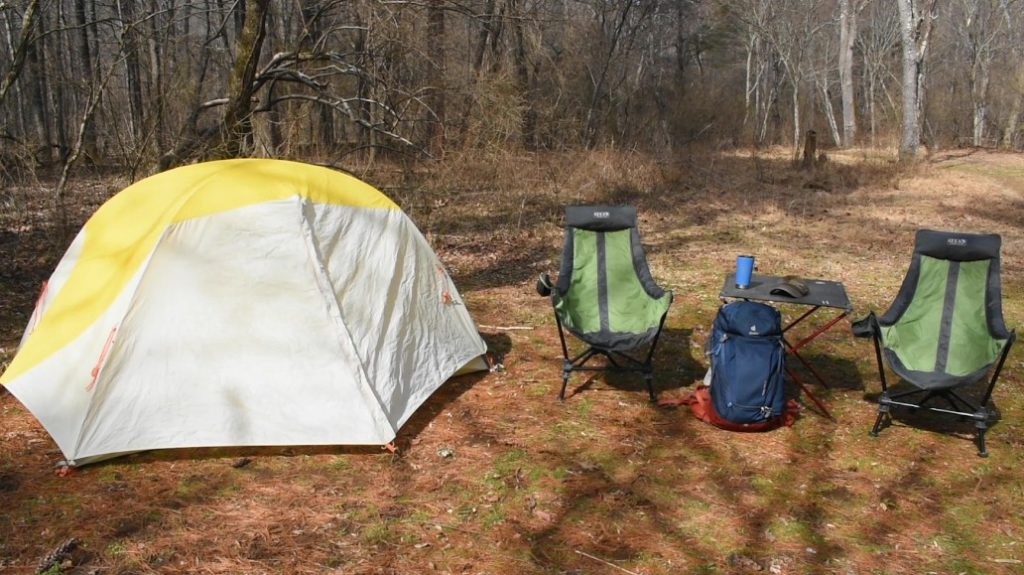Pitching a tent and keeping the elements away from you and your belongings is a crucial step towards having a safe and enjoyable time in the outdoors. It’s easy to learn how to pitch a tent properly – it just takes a little time and effort to master.
To me, no other outdoor skill makes people more irritable and frustrated with each other than pitching a tent. However, when everyone involved is up to speed, pitching a tent is the least of anyone’s worries. The following tent-pitching guide might be useful for you so you can keep everybody warm and happy
What You’ll Need
This list can change depending on the area in which you intend to camp, but normally you should bring:
- Tent
- Rainfly
- Tent poles
- Guylines
- Stakes
- Tarp
- Replacement poles/stakes
- Repair kit
At some point you may lose some of these items, but all is not lost. All these items can be improvised, excluded or replaced. An example is one time I lost a tent in a river. After retrieving it I ended up losing one of the poles to the current. Rather than replacing the pole, I simply used some rope and nearby trees to stretch out the tent. You may not need all of these items every time you go camping, but it can pay off to have them all just in case.
The Step-By-Step Guide
Pre-Trip Preparation
When it comes to any activity in the outdoors, including camping, you need to stay focused to keep yourself not just safe, but comfortable. While safety is your ultimate goal, you must also take your comfort into account. There will always be a certain level of discomfort when you’re away from home, but there are limits to what you can withstand. Even if you can survive in an underprepared situation, if you’re not dry and warm, you won’t be able to think straight, let alone enjoy your time. Being prepared is the best way to make sure you keep a clear mind and keep yourself safe.
- Get to know your tent
Get to know the particular features of your tent, how it fits in its carrier and what its capabilities are. Knowing your tent’s capabilities will help you better adapt to anything which the outdoors might put you through on your adventures.
- Tent condition
Look over the tent and rainfly’s condition. Look for holes in the material and repair them if there are any. Take an inventory of poles, stakes, and guylines and replace any which are missing. Depending on the condition of your tent, you may want to replace it.
- Climate and weather
It’s just as easy to bring too much tent as it is to not bring enough. Consider what the climate is going to be like on your trip in order to determine what kind of tent you need. While almost all tents can handle mild conditions, some are better than others once the weather becomes more extreme. Make sure the tent you have matches the situation you’ll be facing.
- Write a checklist
The best way to begin your preparation is to write a checklist. A checklist will help you keep everything you need organized and will also help you see if you’ve forgotten anything. Remember to check your list right before you leave to make sure you don’t leave anything behind.
Once you’ve prepared your tent and gear, you’ll be ready to move onto:
Campsite Selection

Choosing the right place to set up your camp can be more difficult than you think. There are a few factors you’ll need to consider before you put in the work of pitching your tent.
- Where’s the water?
I don’t just mean where the nearest drinking water is. Water is an essential part of all life, and as we enjoy recreation outdoors, we must be mindful of both what it gives and takes from the landscape.
Most places you can camp will require you to maintain a certain distance from any body of water to prevent any waste entering it.
Even if rain isn’t forecast, you should position your tent in a place where water won’t pool underneath it. During wetter times of the year such as early spring, water is stored underground even if there isn’t a stream nearby. Staying dry is vital for your comfort.
- Widow makers
If you’re camping in a forest, chances are there are widow makers, or dead trees which are precariously positioned and can fall at a moment’s notice. Look around your selected campsite for these traps, it’s not always safe to push them over yourself, so it’s better to just put your tent somewhere where if they do fall, they won’t crush you or your belongings.
- Watch the wind
Wind affects how you stay warm when out in the wild. One of the reasons we have tents is to keep the wind off us. Yet they aren’t completely windproof, so it’s important to position your tent in a way that any wind will be deflected across it, rather than blowing straight into the door.
- Uphill/downhill
The ideal place to put a tent is on completely flat ground, but this is rarely possible outside of manmade campsites. Position your tent so that your head rests uphill to keep blood from rushing to your head during the night.
- Clear ground
There will normally be rocks, roots, branches, and all sorts of hard objects which will come between you and a good night’s sleep. Before you lay out your tent, you’ll need to clear all of these from your intended sleeping area.
Once you’ve prepared your tent, accounted for safety and comfort, and selected your location, you’re finally ready for:
More: How to Set Up Tent in Windy Conditions
Pitching Tips
Each tent has a different pitching process, so make sure to read the manual and instructions which are provided. If you don’t have access to the manual, almost every tent follows the same following steps:
- Lay out the tent
- Stake the tent
- Assemble the poles
- String the poles through the guides and insert into the proper corners (tent should lift at this point)
- Drape/connect the rainfly across the top, aligning its zipper with the tent’s zipper
- Stake/tie down guylines to keep the rainfly off the tent
Some tents are simpler than others, but it can take a little time and practice to become accustomed to each one’s particularities.
There are several ways to modify and improve each tent set up. Here are a few ways to optimize your shelter for your next trip:
More: Best Roof Top Tent For Car Camping
Bring a tarp

A tarp is the ultimate tent accessory. At a push, it can even be used as a tent (see photo). It can be a replacement rainfly if anything happens to the original. The way I use it most is before I even lay out the tent, I put the tarp down to provide an extra layer between the ground and my gear. Not all tent bottoms are waterproof, but a tarp will keep most, if not all, moisture from the ground away from your tent.
Choose a tarp which is larger than the bottom of your tent, which will allow you to keep your dirtiest gear outside the tent while still keeping it covered beneath the rainfly. Just make sure to stake down the tarp and weigh down the tent with your gear to stop it from flying away from you.
- Use a stick
It’s completely possible to forget or lose your tent stakes. I’ve done it many, many times. Don’t fret though, because there are two ways to fix this problem.
- Use sticks
- Use a rock
If the ground is soft enough, break pieces off a stick that’s roughly the same size as the stakes. If the ground is too hard or there are too many rocks or roots, take a rock and use it to weigh down the corners of the tent.
- Forgotten your poles?
It’s heartbreaking when you forget any piece of camping gear, let alone the tent poles. The answer to this embarrassing problem is rope. Position your tent close enough to a group of trees so that you can attach the sides of the tent to the trees and give it at least enough structure to accommodate you and your gear. It won’t be pretty but it will work.
More: 10 Best Backpacking Tent Under $100
Guyline Guidance
The purpose of a rainfly is to keep moisture off the tent. If the rainfly lays against the wall of the tent, it will leak water into the tent. The guylines are what prevent the rainfly from doing this. When you set them up, make sure they can withstand any wind or movement. Waking up to a leaky tent as a result of a fallen guyline is never a pleasant experience.
Guylines also add a structure to the rainfly which helps keep snow and water from building up on the tent. If a guyline won’t stay in the ground, try to tie it around a tree, rock, or other heavy object.
More: Check Our Guide To The Best Six-Person Tent Here
Dos and Don’ts: Pitching a Tent
Most of the dos and don’ts of pitching a tent may seem like common sense, but some you might not think of. Here are some which might help.
Pitching your tent doesn’t have to be as difficult as it seems. When you’ve spent a grueling day hiking and exploring the great outdoors, the last thing you’ll want to do is struggle with putting up a one-man tent. If you follow this guide, it should be easy.
I hope you liked this article. If you did, go ahead and write your thoughts in the comments and share the article with your friends.



